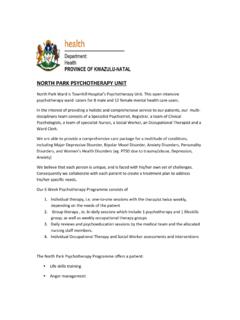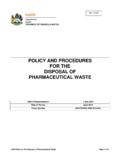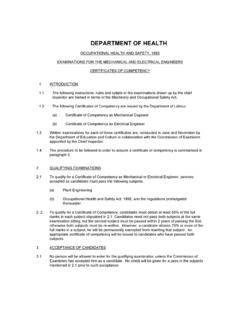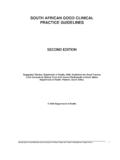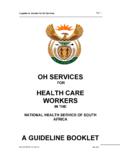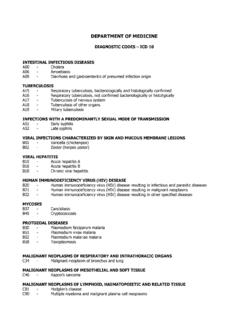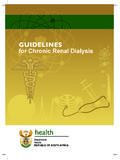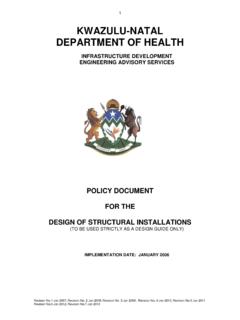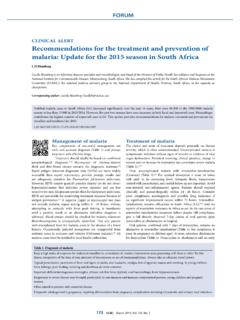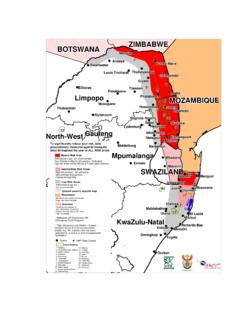Transcription of Saving Mothers: policy and management guidelines for ...
1 Saving MOTHERS policy AND management guidelines FOR COMMON CAUSES OF MATERNAL DEATHS ISBN 1-875017-61-5 FOREWORD The National Department of Health recognises the need to reduce maternal mortality in our country. It therefore set up, and strongly supported, the working of the National Committee on Confidential Enquiries into Maternal Deaths (NCCEMD). The Saving Mothers publication was the beginning of the process of highlighting deaths in pregnancy and these policy guidelines are another step towards reducing maternal deaths in the next few years. These policy guidelines were developed by the Collaborative guidelines Group which consisted of a wide range of health professionals involved in the care of pregnant women. Representatives of nursing, medical and administrative groups was sought and obtained. The consultation process was extensive and draft guidelines were circulated, revised, and re-circulated to the various groups.
2 There was consultation with representatives from medical schools and nursing colleges, DENOSA, SAMA, the College of Obstetricians and Gynecologists, and the NCCEMD. A special effort has been made to make the guidelines applicable to the situation in South Africa. The guidelines presented here are not casting stones, and as new developments occur and proven to be benefit, they will be included in revised versions of the guidelines . However, these guidelines are drawn from the best information available today and are the most suitable to South African conditions in 2000. Each institution (clinic, community center, hospital) should use the policy guidelines to create institutional guidelines , which provides maternity care, and should then be implemented into clinical practice.
3 Appropriate implementation is important so that all staff are not only aware of the guidelines , but utilize them constantly. guidelines , however, are of little value unless some kind of audit occurs at regular intervals. Feedback will lead to updates in guidelines and further improvements in clinical practice. The National Department of Health therefore intends to inspect institutions during the period 2001/2002, to ensure that guidelines are available at all sites of maternity care in the country. CONTENTS PAGE NO: CHAPTER ONE policy AND management guidelines 1 DIFFERENCES BETWEEN guidelines AND PROTOCOLS 2 LEVELS OF CARE 4 CHAPTER TWO A SYSTEMATIC APPROACH TO EXAMINING AN ILL PREGNANT PATIENT 6 SYSTEMATIC EVALUATION FOR THE PRESENCE OF ORGAN DYSFUNCTION 7 THE BIG FIVE 8 THE FORGOTTEN FOUR
4 11 THE CORE ONE 13 CHAPTER THREE guidelines FOR THE management OF HYPERTENSION IN PREGNANCY 24 DEFINITION. 24 HYPERTENSIVE DISEASES IN PREGNANCY AFFECT MANY ORGANS. 24 GENERAL MEASURES TO PREVENT MATERNAL DEATHS FROM HYPERTENSIVE DISEASES. 25 HOW IS BLOOD PRESSURE TAKEN IN PREGNANCY? 26 WHAT IS ABNORMAL BLOOD PRESSURE? 26 WHAT IS DANGEROUSLY ABNORMAL?
5 26 WHICH PATIENTS ARE MORE AT RISK? 26 CONTENTS PAGE NO: SPECIFIC MEASURES. 27 DELIVERY 29 PEURPERIUM. 30 INDICATIONS FOR REFERRAL OR DIRECT REFERRAL TO LEVEL THREE CARE (TERTIARY, CENTRAL OR TEACHING HOSPITAL) 30 PREREQUISITE FOR REFERRAL FOR SECONDARY HOSPITAL 31 TRANSPORT 31 PATIENTS WHO MAY BE DELIVERED IN A LEVEL TWO CARE (DISTRICT, SECONDARY OR REGIONAL HOSPITAL)
6 31 ESSENTIAL SPECIAL INVESTIGATIONS FOR PATIENTS WITH SEVERE PRE-ECLAMPSIA / ECLAMPSIA 33 INDICATIONS FOR TERMINATION OF PREGNANCY 33 PREREQUISITE FOR EXPECTANT management IN LEVEL THREE HOSPITAL 33 DRUGS FOR CHRONIC CONTROL OF HYPERTENSION 34 management NOT RECOMMENDED OR TO BE USED WITH GREAT CAUTION 34 COMMENTS 34 REFERENCES 34 CHAPTER FOUR guidelines FOR THE PREVENTION AND TREATMENT OF PREGNANCY RELATED sepsis 35 INTRODUCTION 35 DEFINITION 36 CONTENTS PAGE NO.
7 SPECIFIC PREVANTATIVE MEASURES 36 ASSESSMENT AND EVALUATION OF THE SEVERITY OF sepsis , COMPLICATING AN ABORTION 38 ASSESSMENT AND EVALUATION OF THE SEVERITY OF PEURPERAL sepsis 39 SYSTEMATIC EVALUATION OF POST PARTUM/ABORTION PATIENTS FOR THE PRESENCE OF ORGAN DYSFUNCTION 40 management AT DIFFERENT LEVELS OF CARE 42 REFERRAL CRITERIA 44 OBSERVATIONS POST PROCEDURE 45 BASIC guidelines FOR OBSERVATIONS 45 CONCLUSION 46
8 REFERENCES 47 CHAPTER FIVE guidelines management OF OBSTETRIC HAEMORRHAGE 48 INTRODUCTION 48 GENERAL PREVENTATIVE MEASURES 48 SPECIFIC PREVENTATIVE MEASURES 49 PROBLEM RECOGNITION 50 management AND REFERRAL guidelines 51 OBSERVATION guidelines 53 AUDIT 54 CONCLUSION 54 REFERENCES 54 CONTENTS PAGE NO.
9 CHAPTER SIX guidelines FOR VAGINAL DELIVERY AFTER CAESAREAN SECTION 55 ANTENATAL CARE 55 PLACE OF VAGINAL DELIVERY 55 PATIENT S CONSENT 55 ADVANTAGES OF VBAC 56 DISADVANTAGES OF VBAC 56 ADVANTAGES OF ELECTIVE CAESAREAN SECTION (C/S)
10 56 DISADVANTAGES OF ELECTIVE CAESAREAN SECTION 56 CONTRAINDICATIONS FOR VBAC 56 CIRCUMSTANCES SUITABLE FOR VBAC 58 management OF TRIAL OF LABOUR 58 REFERENCES 59 CHAPTER SEVEN guidelines FOR RESUSCITATION IN PREGNANCY 60 PREVENTION OF CIRCUMSTANCES LEADING TO COLLAPSE 60 ENSURING PREPAREDNESS FOR CARDIO PULMONARY RESUSCITATION 61 management OF CARDIO-RESPIRATORY ARREST 61 COMPLICATIONS DURING OBSTETRIC ANAESTHESIA 62 PROTOCOL FOR management OF FAILED INTUBATION.
